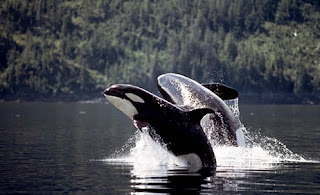Eight tons of pure power whacks an ice floe floating in cold Arctic waters. The seal lying on top of the ice doesn't stand a chance. Knocked into the sea, the seal becomes a meal for one of the ocean's top predators—the huge orca, or killer whale. Orcas hunt everything from fish to walruses—seals, sea lions, penguins, squid, sea turtles, sharks, and even other kinds of whales.
Depending on the season and where they are, their diet varies—some orcas eat more fishes and squid than seals and penguins. But wherever they are in any of the world's oceans, average-sized orcas may eat about 500 pounds (227 kilograms) of food a day. Orcas have many hunting techniques, and bumping seals off ice is just one of them.
Often referred to as wolves of the sea, orcas live and hunt together in cooperative pods, or family groups, much like a pack of wolves. They work together as they hunt. Groups of orcas cooperate to herd fish into a compact area so that they're easier to eat.
They will also slap their tails onto the water's surface, causing a wave to wash prey, such as penguins or sea lions, off ice floes and into the water. Sometimes a pod of whales will join forces to surround a larger animal, such as a blue whale. They chase, bite, and wear it down until it becomes a meal.
Orcas' teeth, numbering about 45 and each measuring about 3 inches (7.6 centimeters) long, are shaped for ripping and tearing prey. Orcas do not chew their food. They can swallow small seals and sea lions whole-the prey slides down the orcas' throats!
Bigger prey is eaten in chunks. The color pattern of orcas may help them sneak up on and attack their prey. Their backs are black, their stomachs are white. Animals looking down on an orca from above, such as a seal on an ice floe, might not see it because the whale's dark back blends with the water below.
On the other hand, the whale's white underside blends with the light streaming down into the sea from the surface, making it hard to spot from below.
With orcas camouflaged so well, those prey fish, penguins, or seals are likely to miss the danger heading their way, as the killer whale once again proves it is the oceans' superbly designed hunter.
 FAST FACTS
FAST FACTSMale orcas average 19 to 22 feet (6 to 7 meters) in length; females average 16 to 19 feet (5 to 6 meters) long.
Male orcas weigh, on average, 8,000 to 12,000 pounds (3,600 to 5,500 kilograms).
Female orcas weigh 3,000 to 8,000 pounds (1,400 to 3,600 kilograms).
The scientific name for the orca, or killer whale, is Orcinus orca.
Orcas, like other whales, have dorsal fins (on their backs).
Male orcas have the tallest dorsal fin of any whales; they can stand 6 feet (1.8 meters) high.
Orcas, like other whales, have dorsal fins (on their backs).
Male orcas have the tallest dorsal fin of any whales; they can stand 6 feet (1.8 meters) high.
Orcas have good eyesight both underwater and above the surface.
Orcas usually swim at a speed of about 3 to 4 miles (5 to 6.4 kilometers) an hour.
Orcas usually swim at a speed of about 3 to 4 miles (5 to 6.4 kilometers) an hour.
Each lobe of the whale's tail is called a fluke.
Orcas are able to reach a speed of about 30 miles (48 kilometers) an hour.
A thick layer of fat, or blubber, helps an orca stay warm even in icy waters.
Orcas are able to reach a speed of about 30 miles (48 kilometers) an hour.
A thick layer of fat, or blubber, helps an orca stay warm even in icy waters.
Orcas are toothed whales and a kind of dolphin. They are the largest of all dolphins.
Orcas are mammals.
Orcas live in every ocean around the world, but are most common in Arctic and Antarctic waters.
A baby orca, or calf, is usually born tail-first. It weighs about 400 pounds (180 kilograms).
Orcas are mammals.
Orcas live in every ocean around the world, but are most common in Arctic and Antarctic waters.
A baby orca, or calf, is usually born tail-first. It weighs about 400 pounds (180 kilograms).
Orca females average one birth every ten years. Some females may give birth every three to five years.
Newborn orcas are about 8 feet (2.4 meters) long.
When an orca is first born, its mother helps it swim to the surface for its first breath. Within a short time of birth, it can swim on its own.
Newborn orcas are about 8 feet (2.4 meters) long.
When an orca is first born, its mother helps it swim to the surface for its first breath. Within a short time of birth, it can swim on its own.
Female orcas tend to live longer than males. Females can live to be 90 years old; males live about 50 years. An orca's only enemy is people.
The largest male orca ever recorded was 32 feet (10 meters) long. It weighed 22,000 pounds (10,000 kilograms).
The largest male orca ever recorded was 32 feet (10 meters) long. It weighed 22,000 pounds (10,000 kilograms).

No comments:
Post a Comment